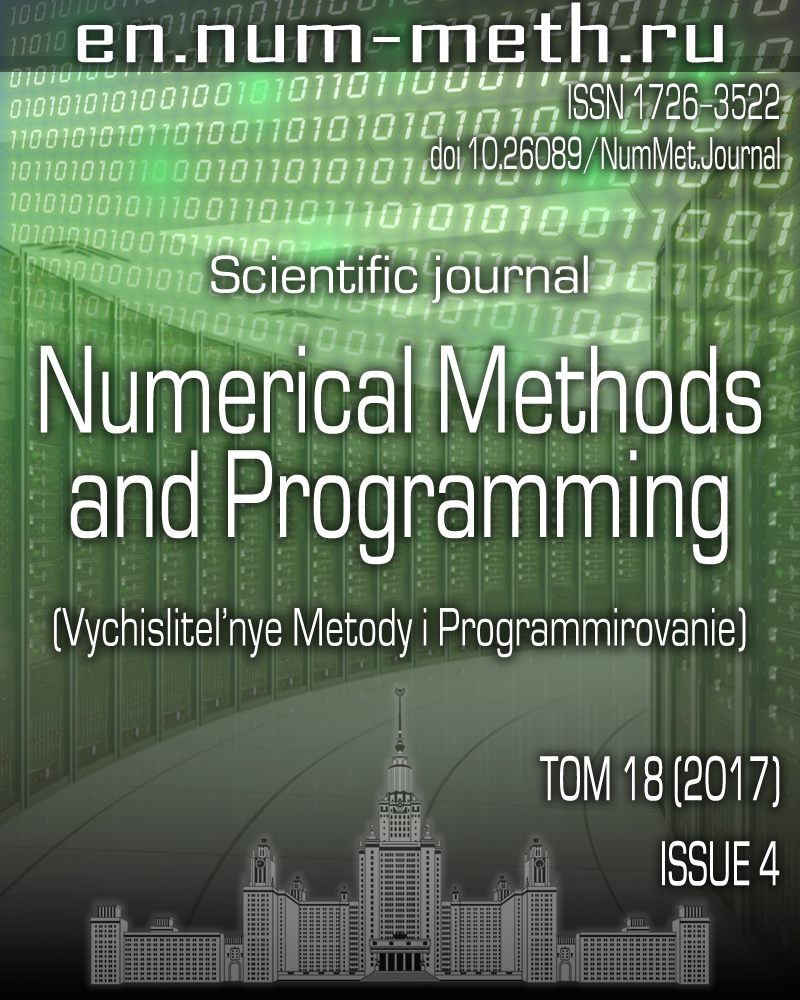DOI: https://doi.org/10.26089/NumMet.v18r432
Mechanical losses in glassy silicon dioxide: results of atomistic simulation
Keywords:
mechanical losses
molecular dynamics
glassy silicon dioxide
Abstract
Two methods to estimate the mechanical energy losses in solid materials are proposed. These methods are based on the molecular dynamics simulation of external actions on the body’s structure, followed by its relaxation. The inverse quality factor and its Fourier transform are estimated on the frequency equal to the reverse time of relaxation. The inverse quality factor is estimated from above by 10-4, which corresponds to experimental data. The Fourier transform is estimated from above by 10-2.
Published
2017-09-20
Issue
Section
Section 1. Numerical methods and applications
References
- G. Harry, T. P. Bodiya, and R. DeSalvo (Eds.), Optical Coatings and Thermal Noise in Precision Measurement (Cambridge University Press, Cambridge, 2012).
- W. A. Phillips, “Tunneling States and the Low-Temperature Thermal Expansion of Glasses,” J. Low Temp. Phys. 11 (5-6), 757-763 (1973).
- P. W. Anderson, B. I. Halperin, and C. M. Varma, “Anomalous Low-Temperature Thermal Properties of Glasses and Spin Glasses,” Phil. Mag. 25 (1), 1-9 (1972).
- R. Hamdan, J. P. Trinastic, and H. P. Cheng, “Molecular Dynamics Study of the Mechanical Loss in Amorphous Pure and Doped Silica,” J. Chem. Phys. 141 (2014).
doi 10.1063/1.4890958 - J. P. Trinastic, R. Hamdan, C. Billman, and H.-P. Cheng, “Molecular Dynamics Modeling of Mechanical Loss in Amorphous Tantala and Titania-Doped Tantala,” Phys. Rev. B 93 (2016).
doi 10.1103/PhysRevB.93.014105 - F. V. Grigoriev, A. V. Sulimov, I. V. Kochikov, et al., “High-Performance Atomistic Modeling of Optical Thin Films Deposited by Energetic Processes,” Int. J. High Perf. Comp. Appl. 29} (2), 184-192 (2015).
- F. V. Grigoriev, “Force Fields for Molecular Dynamics Simulation of the Deposition of a Silicon Dioxide Film,” Vestn. Mosk. Univ., Ser. 3: Fiz., No. 6, 93-97 (2015) [Moscow Univ. Phys. Bull. 70 (6), 521-526 (2015)].
- F. V. Grigoriev, A. V. Sulimov, E. V. Katkova, et al., “Full-Atomistic Nanoscale Modeling of the Ion Beam Sputtering Deposition of SiO{}_2 Thin Films,” J. Non-Cr. Sol. 448, 1-5 (2016).
- F. V. Grigoriev, E. V. Katkova, A. V. Sulimov, et al., “Annealing of Deposited SiO_2 Thin Films: Full-Atomistic Simulation Results,” Opt. Mat. Exp. 6 (12), 3960-3966 (2016).
- H. J. C. Berendsen, J. P. M. Postma, W. F. van Gunsteren, et al., “Molecular Dynamics with Coupling to an External Bath,” J. Chem. Phys. 81 (8), 3684-3690 (1984).
- V. Sadovnichy, A. Tikhonravov, Vl. Voevodin, and V. Opanasenko, “’Lomonosov’: Supercomputing at Moscow State University,” in Contemporary High Performance Computing: From Petascale toward Exascale (CRC Press, Boca Raton, 2013), pp. 283-307.
- M. S. Blanter, I. S. Golovin, H. Neuh854user, and H.-R. Sinning, Internal Friction in Metallic Materials: A Handbook (Springer, Berlin, 2007).
License
Copyright (c) 2017 Вычислительные методы и программирование

This work is licensed under a Creative Commons Attribution 4.0 International License.


